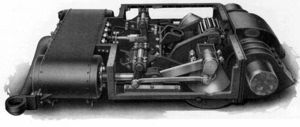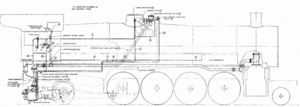Booster engine
A booster engine for steam locomotives is a small two-cylinder steam engine back-gear-connected to the trailing truck axle on the locomotive or, if none, the lead truck on the tender. A rocking idler gear permits it to be put into operation by the engineer. It would drive one axle only and could be non-reversible with one idler gear or reversible with two idler gears.
They were used to start a heavy train or maintain low speed under demanding conditions. It could be cut in while moving at speeds under 15 mph (24 km/h). Rated at about 300 hp (224 kW) at speeds of from 10 to 30 miles per hour (16 to 48 km/h). It would automatically cut out at 30 mph (48 km/h). Tractive effort of 10-12,000 lbf (44 to 53 kN) was common.
Tender boosters were equipped with side-rods connecting axles on the lead truck. Such small side-rods restricted speed and thus confined to switching locomotives, often used in transfer service between yards. Such boosters were far rarer than engine boosters.
Reasons for booster use
The booster is intended to address fundamental flaws of the standard steam locomotive. First, most steam locomotives do not provide power to all wheels. The amount of force that can be applied to the rail depends on the weight on driven wheels and the factor of adhesion of the wheels against the track. Unpowered wheels effectively 'waste' weight which could be used for traction. Unpowered wheels are generally needed to provide stability at speed, but at low speed this is not necessary.
Second, the "gearing" of a steam locomotive is constant, since the pistons are linked directly to the wheels via rods and cranks. Since this is fixed, a compromise must be struck between ability to haul at low speed and the ability to run fast without inducing excessive piston speeds (which would cause failure) or the exhaustion of steam. This compromise means that the steam locomotive at low speeds is not able to use all the power the boiler is capable of producing; it simply cannot use steam that quickly, and there is a big gap between the amount of steam the boiler could produce and the amount that can be used. The booster enables that wasted potential to be put to use.
Disadvantages
Boosters were costly to maintain with their flexible steam and exhaust pipes, idler gear etc.
Usage
The booster saw most use in North America. Railway systems elsewhere often considered the expense and complexity unjustified.
Even in the North American region, booster engines were applied to only a tiny fraction of all locomotives built. Some railroads used boosters extensively while others did not. The New York Central was a fan of the booster and applied it to all of its 4-6-4 Hudson locomotives. The rival Pennsylvania Railroad, however, used few booster-equipped locomotives.
Canadian Pacific Railway rostered a grand total of 3257 steam locomotives acquired between 1881 and 1949, yet only 55 were equipped with boosters. 17 H1 class 4-6-4s, 2 K1 class 4-8-4s and all 36 T1 class 2-10-4s.
In Australia, Victorian Railways equipped all but one of its X class 2-8-2 locomotives (built between 1929 and 1943) with a 'Franklin' two cylinder booster engine after the successful trial of the device on a smaller N class 2-8-2 in 1927. The South Australian Railways 500 class 4-8-2 heavy passenger locomotives were rebuilt into 4-8-4s with the addition of a booster truck from 1929 onwards.
NZR's Kb class of 1939 were built with booster trucks to enable the locomotives to handle the steeper grades of the South Island lines.
References
- Bruce, Alfred W. (1952). The Steam Locomotive in America. Bonanza Books, New York.
- Railway Master Mechanics' Association (1922). Locomotive Cyclopedia of American Practice, Sixth Edition—1922. Simmons-Boardman.


